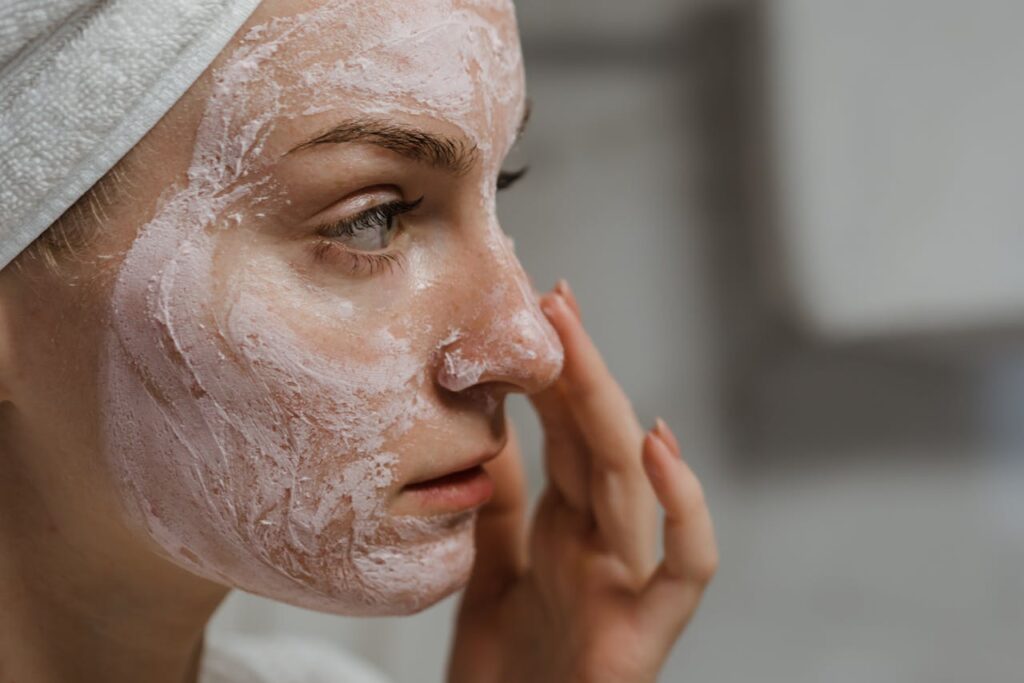Niacinamide is a popular ingredient in anti-aging products, known to soften fine lines and wrinkles, smooth uneven skin tone and texture, brighten dark under-eye circles, and boost collagen production. But what about its effects on acne? Join us to learn if niacinamide is really good for acne, and a few considerations to keep in mind as you incorporate it into your skincare routine.
What exactly is niacinamide?
Niacinamide is a water-soluble form of vitamin B3 that plays a crucial role in maintaining skin health. It’s found naturally in foods like meat, nuts, and green vegetables, but topical applications deliver targeted benefits that can help strengthen the skin barrier, improve hydration, reduce redness, and minimize the appearance of pores and fine lines.
How does niacinamide work?
You can think of niacinamide as the ultimate skin balancer. It’s a multitasking skincare powerhouse that regulates oil production, calms inflammation, and improves barrier function for skin that looks healthier because it is healthier.
Is niacinamide safe?
In most cases, niacinamide is gentle enough for daily usage. Many people (even those with sensitive skin and rosacea) can use it twice a day without adverse effects. Consider starting with concentrations between 2% and 5% for optimal results.
Are there any side effects to niacinamide?

Although niacinamide is generally considered safe, some people may experience side effects like:
- Mild flushing, redness, and tingling
- Temporary breakouts
- Increased sensitivity
Related: Is Hyaluronic Acid Good for Acne?
Is niacinamide good for acne and scarring?
Many people find that niacinamide is good for both acne and scarring, thanks to its multifaceted approach to skin health:
Anti-inflammatory properties
Acne-prone skin is often plagued by inflammation, with redness, swelling, and tenderness further irritating pimples. Niacinamide is a powerful anti-inflammatory ingredient that encourages faster healing and minimizes the risk of post-inflammatory hyperpigmentation.
Regulates sebum production
Acne and oil go hand-in-hand. As your skin generates excess sebum, this oily substance can clog pores, trapping bacteria and dead skin cells beneath the skin’s surface. Niacinamide balances oil production, making it a good addition to your acne-banishing skincare routine.
Reduces hyperpigmentation
Dark spots and discoloration that linger long after a breakout are signs of post-inflammatory hyperpigmentation. However, niacinamide can slow the transfer of melanin to these inflammation hotspots, gradually evening out your skin tone and erasing discoloration. It’s important to exfoliate regularly when using niacinamide to improve your skin tone, as this product alone won’t impact cellular regeneration.
Improves skin barrier function
A healthy skin barrier retains moisture and protects deeper layers from irritants and harmful bacteria, but harsh topical products, intense resurfacing treatments, and years of sun exposure break down this critical line of defense. Niacinamide boosts the production of ceramides and fatty acids, so your face can tolerate topical acne treatments without becoming dry, sensitive, and irritated.
Suitable for all skin types
Whether your skin is oily and acne-prone or dry and sensitive, niacinamide can improve the health of your outer layer. In fact, it’s among the most well-tolerated active ingredients in modern skincare, safe even for many people with highly reactive skin and rosacea.
Can be used alongside other acne treatments
Niacinamide isn’t just good for acne. It’s also gentle enough to be used alongside more potent acne treatments like azelaic acid, salicylic acid, vitamin C, and retinoids.
Related: What Are the Best Facial Treatments for Acne?
What to consider when using niacinamide for acne
We know how exciting it can feel to discover a new product that promises to balance your skin and finally eliminate your acne, but it’s good to take it slow, even with gentle, soothing products like niacinamide. Here are a few factors to keep in mind:
Consult with your provider
If you have moderate to severe acne or you’re already using prescription acne treatments, it’s good to talk with your dermatologist before adding niacinamide to your daily lineup. They can help you modify your existing regimen to support a seamless, irritation-free transition and help ensure optimal compatibility within your routine.
Individual results vary
It’s true: niacinamide is generally considered safe and effective for most people, making it a good product for acne. However, there’s no one-size-fits-all solution for breakouts, and some folks may not respond positively. It all depends on your skin’s chemistry, skincare routine, and the severity of your acne.
Patch test new products

Depending on the other products in your skincare routine, you can add niacinamide to your routine through your facial cleanser, toner, moisturizer, or mask. No matter where you choose to incorporate this acne-fighting addition, remember to patch test each new product in an inconspicuous area and monitor your skin’s reaction over the following 24 to 48 hours.
Start with low concentrations or active ingredients and introduce only one new product at a time, allowing your skin time to adjust before adding another topical ingredient. A high-quality hyaluronic acid serum and zinc-based cream can soothe reactivity and help your skin acclimate to a new routine.
Related: AHA vs BHA: Differences, Benefits, and Uses
Enhance your health and happiness with advanced skin and body treatments at The Wellness Club!
In most cases, niacinamide is good for folks with acne, especially when used alongside prescription-strength remedies and professional treatments, like our signature Acne Facial. Book a consultation today to discover how a holistic approach can help you banish breakouts for good!

